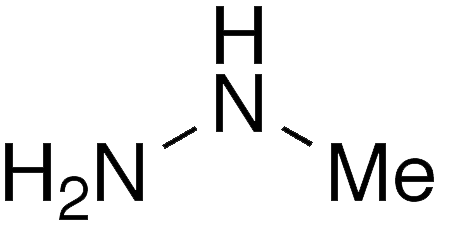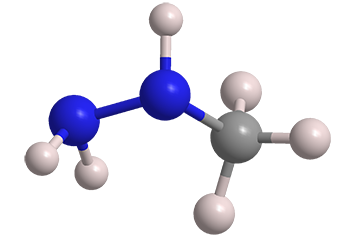What molecule am I?


We begin 2023 with the nasty molecule methylhydrazine. As shown in the hazard information table, the compound, also called monomethylhydrazine (MMH), is deadly to humans and environmentally harmful. It is, unexpectedly, found in nature.
Methylhydrazine has been known since at least 1888, when German chemist Gustav von Brüning initiated a series of articles on the molecule. In 1890, he reported a synthesis of MMH that began with the preparation of 1-nitroso-1-methylurea from methylurea nitrate and sodium nitrite. The nitroso compound was then reduced with zinc dust in acetic acid to produce MMH after an extensive workup procedure.
In 1954, L. F. Audrieth* and L. H. Diamond at the University of Illinois (Urbana–Champaign) reported a more concise synthesis: They prepared methylhydrazine and other monosubstituted hydrazines via the reaction of methylamine with chloramine. This process is used for the modern industrial production of MMH. The compound’s main uses are in rocket propellants and the synthesis of higher hydrazine derivatives and other organic chemicals.
Where does methylhydrazine turn up in nature? It is one of the deadliest compounds in poisonous mushrooms. It is found in Gyromitra spp., in which it is formed when the native toxin gyromitrin1 hydrolyzes. Other lethal mushroom poisons include α-amanitin2, orellanine3, and ergotamine4.
1. CAS Reg. No. 16568-02-8.
2. CAS Reg. No. 23109-05-9.
3. CAS Reg. No. 37338-80-0.
4. CAS Reg. No. 113-15-5.
Methylhydrazine hazard information
| Hazard class* | GHS code and hazard statement | |
|---|---|---|
| Flammable liquids, category 2 | H225—Highly flammable liquid and vapor | |
| Acute toxicity, oral, category 2 | H300—Fatal if swallowed | |
| Acute toxicity, dermal, category 2 | H310—Fatal in contact with skin | |
| Skin corrosion/irritation, category 1B | H314—Causes severe skin burns and eye damage | |
| Serious eye damage/eye irritation, category 1 | H318—Causes serious eye damage | |
| Acute toxicity, inhalation, category 1 | H330—Fatal if inhaled | |
| Carcinogenicity, category 1B | H350—May cause cancer | |
| Short-term (acute) aquatic hazard, category 1 | H400—Very toxic to aquatic life | |
| Long-term (chronic) aquatic hazard, category 1 | H410—Very toxic to aquatic life with long-lasting effects | |
*Globally Harmonized System (GHS) of Classification and Labeling of Chemicals. Explanation of pictograms.
This molecule was suggested by a reader. We present almost all of the molecules suggested by our readers. If you have a molecule you would like us to consider, please send us a message. And thank you for your interest in Molecule of the Week! —Ed.
Methylhydrazine fast facts
| CAS Reg. No. | 60-34-4 |
| SciFinder nomenclature | Hydrazine, methyl- |
| Empirical formula | CH6N2 |
| Molar mass | 46.07 g/mol |
| Appearance | Fuming colorless liquid |
| Odor | Similar to ammonia and small aminoalkanes |
| Boiling point | 87.5 °C |
| Water solubility | Miscible |
MOTW update
Cubane1 was the Molecule of the Week for March 10, 2008. As its name implies, it is a highly symmetrical cubic molecule. It is thermally unstable because of the high strain of its 90° bond angles.
In December, Xujun Cheng, Stephen L. Craig, and co-workers at Duke University (Durham, NC) described the mechanochemistry of cubane. When a cubane derivative with polymeric side chains at the 1- and 2-positions was subjected to pulsed ultrasonication, the only product was the corresponding syn-tricyclooctadiene, in contrast to the cyclooctatetraene derivative formed by thermal isomerization.
1. CAS Reg. No. 277-10-1.

Learn more about this molecule from CAS, the most authoritative and comprehensive source for chemical information.
Molecule of the Week needs your suggestions!
If your favorite molecule is not in our archive, please send us a message. The molecule can be notable for its current or historical importance or for any quirky reason. Thank you!
Stay Ahead of the Chemistry Curve
Learn how ACS can help you stay ahead in the world of chemistry.

